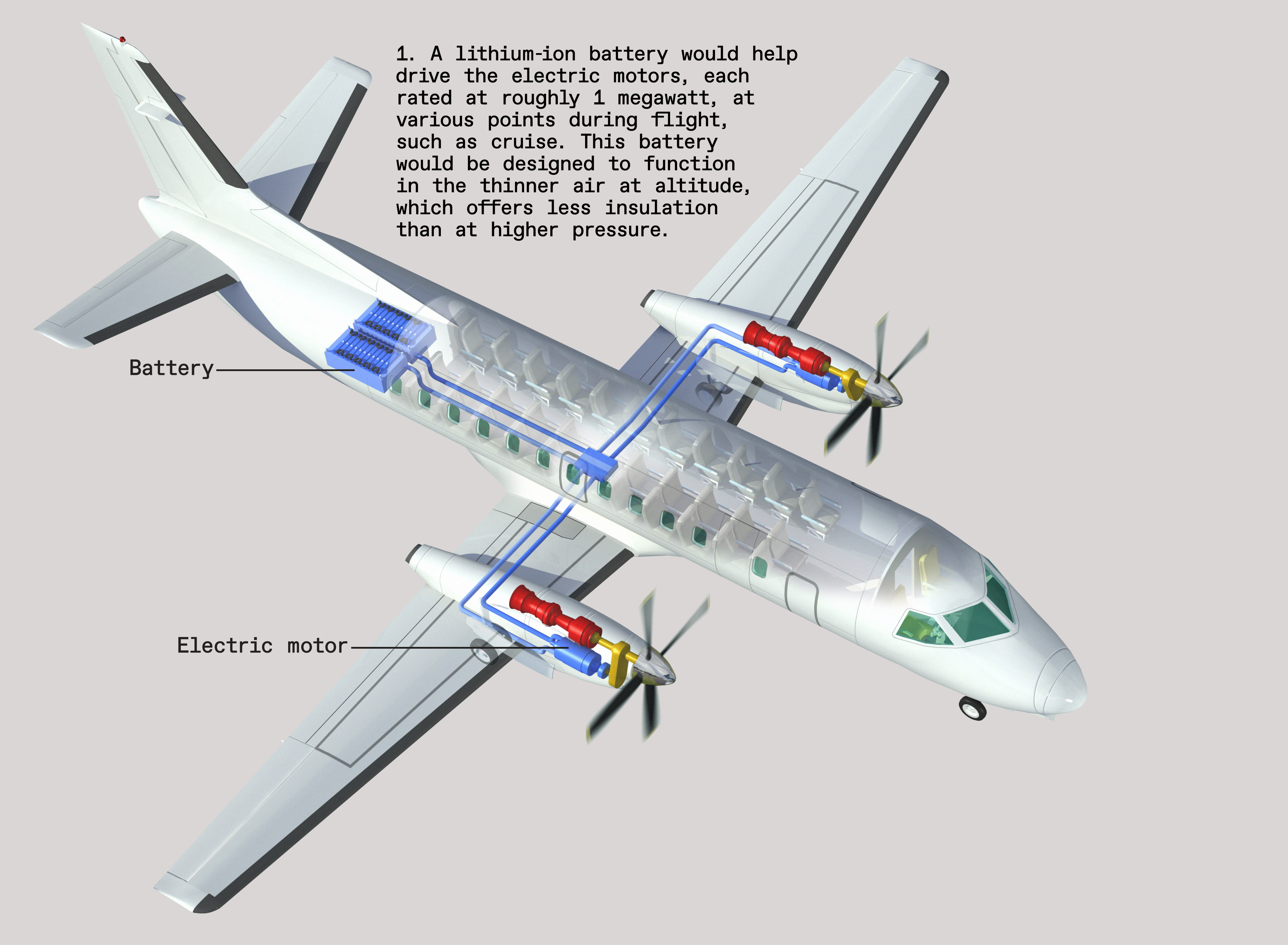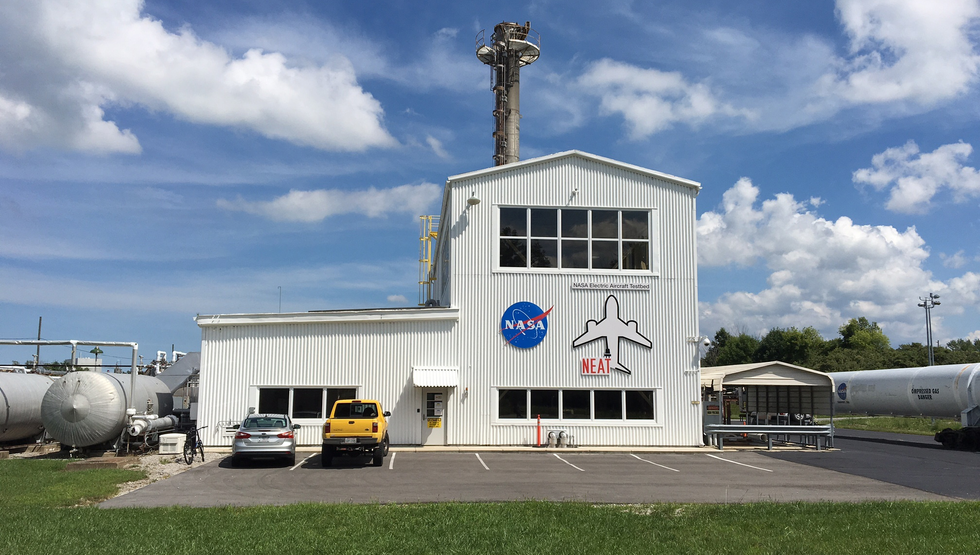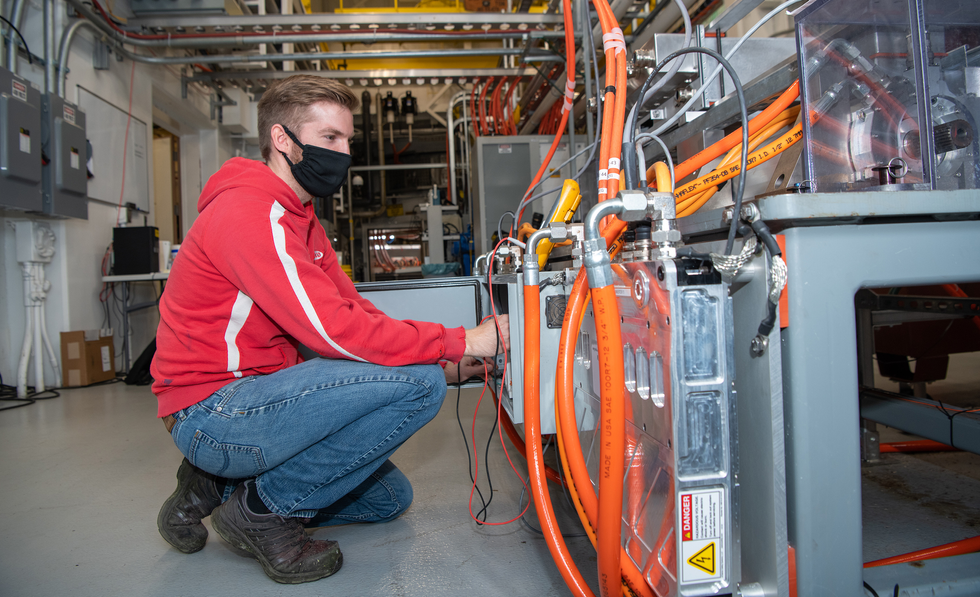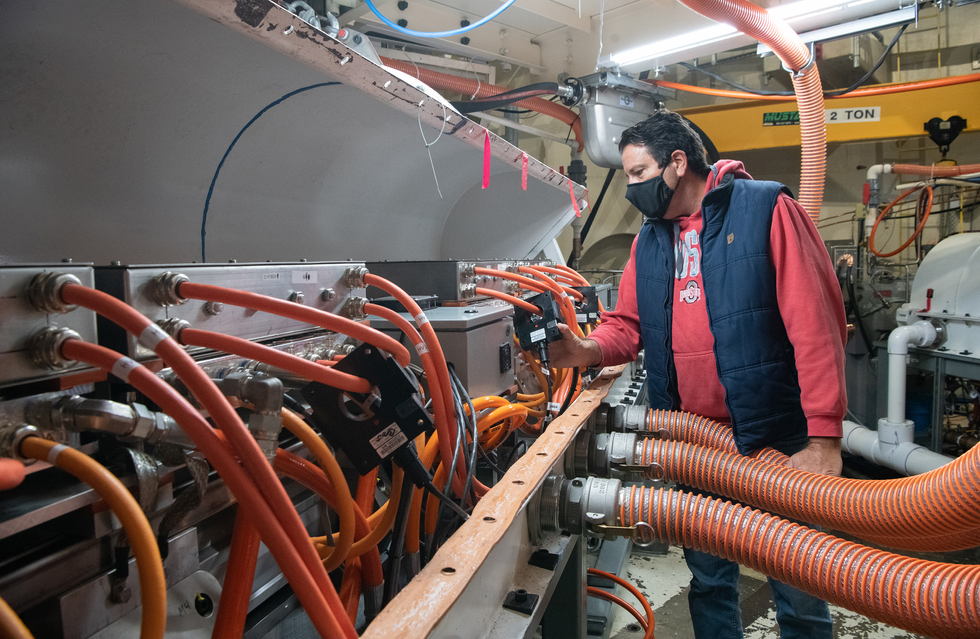Fly the Hybrid Skies
NASA, GE Aerospace, and Boeing are collaborating on a hybrid-electric airliner

Researchers are now retrofitting regional aircraft in order to test hybrid-electric propulsion systems. On one of these retrofits, each of the two nacelles would house an electric motor of about a megawatt as well as a turbine engine.
Commercial aviation is the connective tissue of the modern world. Just before the global pandemic, on an average day 12 million people flew on some 100,000 commercial flights, according to the International Civil Aviation Organization (ICAO). The numbers have now come roaring back: Industry revenues are expected to reach US $803 billion in 2023, 9.7 percent more than in 2022 and nearly up to the prepandemic peak, in 2019.
With increased air mobility comes more impact on the planet. Air traffic contributes around 2 percent of worldwide carbon emissions. It also produces contrails, which are being studied for their impact on climate change. Air travel depends on nonrenewable fossil fuels, and its noise afflicts communities near airports or beneath a flight path.
Aviation regulators are uniting to address these concerns. In October 2022, the ICAO adopted the goal of net-zero carbon emissions from commercial flights by 2050. In the United States, an Aviation Climate Action Plan had already emerged with essentially the same goal.The challenge is how to reduce emissions while enabling the expansion in air travel to support economic growth and the personal and social benefits of travel. Meeting such a challenge will require fundamental changes to the airplane and how it’s operated.
GE: Advancing Hybrid Electric Propulsionwww.youtube.com
Companies small and large, including the world’s major manufacturers of airliners and large jet engines—Airbus, Boeing, CFM International, Embraer, GE Aerospace, RTX’s Pratt & Whitney, Rolls-Royce, and Safran Aircraft Engines among them—have revealed plans for reducing air-travel emissions. Common tactics include introducing sustainable fuel, such as fuel derived from biomass, which can cut life-cycle carbon emissions by absorbing them during production. Other research efforts include tactics based on powering planes with ammonia, hydrogen, or electricity.
In a major effort in the United States, NASA and industry partners are advancing flight demonstrators to develop electrically powered propulsion systems. In this joint effort, GE Aerospace and Boeing’s Aurora Flight Sciences are working together to advance a hybrid-electric propulsion concept capable of powering a 150- to 180-seat single-aisle airplane. The project, called Electrified Powertrain Flight Demonstration (EPFD), has been underway since 2021 and has as a major goal the modification of a Saab 340 aircraft to a hybrid propulsion system. Two of GE’s CT7 engines will be combined with electric-propulsion units to demonstrate a megawatt-class parallel hybrid electric system.
Another NASA campaign under EPFD with magniX and its partners AeroTEC and Air Tindi will demonstrate a plane concept powered by two Pratt & Whitney PT6A engines and two magniX magni650 electric-propulsion units. This project is targeting the shorter distance, 19-to-50-seat market.
Together, the EPFD initiative joins a suite of flight demonstrations that are planned worldwide. We are in the early stages of a key transition: Electrification could be the first fundamental change in airplane propulsion systems since the advent of the jet engine.
Why Hybrid Electric?
The work comes as the commercial aviation industry reaches a crossroads. Until now, airlines could count on substantial efficiency improvements from one airplane generation to the next. A 2022 study by McKinsey & Co. noted that historically, when airlines upgraded to a new generation of airplanes, they could count on increases in fuel efficiency between 15 and 20 percent.
However, the jet engine has been evolving for over 80 years and those efficiency percentages have been getting more difficult to reach. The propulsive and aerodynamic efficiencies now being achieved are difficult to beat for airplanes that carry large numbers of people up to 3,500 nautical miles (6,500 kilometers).
Consider the modern turbofan jet engine. Its fuel stores about 43 megajoules of energy per kilogram, and a current-model engine can convert that stored energy into thrust with an efficiency of around 40 percent. Hydrogen contains far more energy per unit of mass but far less per unit of volume. That problem, together with challenges related to the production, availability, and storage of hydrogen, will take many years to overcome.
Fortunately, another technological revolution is well underway in the automotive industry, which is being transformed by advances in power electronics, electric motors, and energy storage. Advanced semiconductors, motors, and batteries are enabling energy-conversion efficiencies above 90 percent and continuously improving the ratio of power to weight. These same advances are offering enticing new options for airplane designers.
Complications of Electrifying Flight
Electrification, however, faces unique and in many cases greater challenges in an aircraft than in a car, particularly in areas related to reliability and weight.
Thus, to enable these architectures for larger planes, a great deal of work is now focused on improving or reducing the weight of the electric motor/generators, the power electronics, the fault-management devices, and the power transmission system. Indeed, NASA is coordinating efforts to develop and deploy new types of electric motor-generators, new structural materials, and power converters that take advantage of emerging wide-bandgap semiconductors and optimized circuit designs.
In flight, safety implications are elevated. In the sky, there’s no option to “pull over.” If a battery catches fire, those on board can’t exit the vehicle.
Weight is a bigger problem, too, because so much of an airplane’s energy is expended simply to get in the air and to stay there. Designers minimize fuel consumption and overall energy usage by optimizing how the propulsion system interacts with the plane’s aerodynamics.
One of the most popular configurations for proposed hybrid-electric commercial jets is the parallel-hybrid system, in which two parallel power sources, typically electricity and a gas turbine, are connected mechanically to drive a propulsor, such as a propeller. For example, both a gas-powered engine and an electric motor can be used to spin the same drive shaft, either separately or together. For takeoff, for example, both propulsion sources might be used, while just one might be used for cruising at altitude. In the aviation industry, many other architectures are also being studied, including all-electric small planes and fully turboelectric twin-aisle passenger jets, whose fuel-burning engines are used as electric generators to power electrically driven fans.
The EPFD project is capitalizing on developments that are more than a decade in the making. These include GE Aerospace’s hybrid-electric propulsion system, comprising advanced motor/generators that fit into a nacelle next to a CT7 turboprop engine, a battery, conversion electronics to provide electrical power, and controls and management systems needed to operate in the hybrid mode.
NASA and GE Aerospace achieved a major milestone in 2022, demonstrating a megawatt-class and multikilovolt hybrid-electric propulsion system in conditions simulating those that would be encountered by a single-aisle passenger airplane at altitudes up to 14,000 meters (45,000 feet).

This altitude integration test began in June 2021 at NASA’s Electric Aircraft Testbed in Sandusky, Ohio. For this test series, engineers at GE Aerospace assembled two sets of a hybrid-electric system, representing the right- and left-engine sides of an airplane, and simulated the electrical loads required to help optimize the engines to propel and power an aircraft.
The test demonstrated the different modes of operation and the flexibility of hybrid-electric propulsion systems in general. Consider a plane with two turbine engines, one under each wing, and an electric motor-generator connected to each engine’s shaft and also electrically connected to a battery system. Each side of the plane has a conversion system that takes DC battery power and converts it to the AC power required to drive the motor that spins the turbine. It also converts AC back to DC, in order to store electrical energy in the battery.
This was the basic configuration tested. NASA systems were used to either drive or be driven by the GE Aerospace motor-generators to provide realistic loads, taking the place of the airplane’s propellers and turbine engines. DC power supplies were also used to simulate the batteries. Once all the components were connected and running, the test took the electric parts through all of the modes of operation that an electrified plane of the future might see during a typical flight—notably takeoff, cruise, and landing.
Significantly, this was all done under simulated-altitude conditions. The systems acted together safely, free of electrical hazard and electromagnetic interference.
High Voltage at Altitude a Significant Barrier
Making all of these systems work together at high voltage and power and at low pressure was a substantial achievement. One of the biggest challenges encountered during these tests was safely implementing higher voltages at the low pressures airplanes encounter when they fly. Voltages in the range of 270 volts are routinely used in airliners, but that is far too low for hybrid-electric propulsion. These airplanes will need two or more electric motors, each rated at 1 MW or more. To adequately power these motors will require on the order of 30 meters of heavy power cabling and long lengths of wound wire in the electric machines.
Keeping these cable weights tolerable causes engineers to seek higher voltages. This is driven by one of the most fundamental of electrical formulas: Ohm’s Law. To power a megawatt-class motor at 100 V requires 10 times as much current as it does to power such a motor at 1,000 V. So if that motor is installed on an airplane, it typically needs to be powered by something closer to 1,000 V. Here’s why: The amount of current a conductor can carry is proportional to its cross-sectional area, but the weight of a wire goes up linearly with cross-sectional area. To keep the weight of the conductors down, it’s necessary to minimize cross-sectional area. That necessity in turn limits the amount of current the wire can carry. And as Ohm’s Law indicates, the only way to limit current is by raising the voltage.

However, the use of high voltages in airplanes also runs up against another electrical formula: Paschen’s Law. This law states, in essence, that the electrical breakdown voltage of a gap between two conductors is determined by the distance between the conductors—and also by the pressure of the gas in the space between them. Lower pressure means a lower breakdown threshold. This is a particular challenge for the electrical systems used aboard airplanes: The pressure at 35,000 feet (11,000 meters), a typical cruising altitude, is around 0.28 atmospheres—or less than a third of what it is at sea level. This means a factor of three reduction, roughly, in breakdown threshold.
Because of the conflicting imperatives of keeping weights low and avoiding the safety hazards caused by voltage breakdown, leaders in electrification are putting a lot of resources toward “breaking the 270-volt barrier.” NASA technology projects are focusing on fault management, safety, and reliability on several fronts. Researchers are looking for material solutions that will reliably protect the gap between conductors without adding weight. This protection is achieved through improved insulation and even multifunctional insulators–layered material systems that can simultaneously serve several purposes. These include protection from the ionization of the air around conductors (the corona effect), providing a moisture barrier, shielding from electromagnetic interference, promoting thermal conductivity, and providing mechanical strength and durability.
Several ongoing efforts are looking at solid-state circuit interrupters that are one-tenth the weight of their ground counterparts and yet can clear a DC fault 10 times as fast. Researchers are also developing circuits and devices designed to reduce noise, interference, and issues related to rapid changes in line voltages and currents that are common to electric power trains.
Electrified Powertrain Flight Demonstration (EPFD) Project
The next steps for developing a commercial hybrid-electric airplane are continuing through NASA’s EPFD project. The teams aim to complete at least two demonstrations and introduce electrical systems to the commercial fleet in the near future.
GE Aerospace engineers are now taking the results of the altitude-integration test carried out in 2022, as well as information from other internal GE Aerospace programs, and using them to build a propulsion system for a piloted aircraft.
That’s where Aurora Flight Sciences comes in. This Boeing subsidiary is integrating the GE Aerospace hybrid-electric system into a Saab 340 plane, a twin-engine turboprop that’s designed to carry 36 passengers. This integration work includes modifying the airplane for the new propulsion system and manufacturing a nacelle to fit the added motor-generator. They also need to design an interface to control the propulsion system from the flight deck and to make sure everything works together safely. If all goes well, the team plans to test-fly the hybrid-propulsion Saab 340 in the mid-2020s.
Demonstrating this technology in flight will allow the GE Aerospace and Boeing teams to address issues related to transmitting electrical power at high voltage through an airplane at altitude, studying electromagnetic interference with other plane systems, system safety, fault management and protection at the airplane level, mass and center-of-gravity management, and thermal management.
Engine-to-Engine Power Transfer
In parallel with addressing design challenges for hybrid-electric propulsion, NASA, GE Aerospace, and Boeing are also working on ways to operate and maintain the entire system.
Flight-testing the hybrid-electric power train integrated into a commercial aircraft at operational altitudes will provide the team with practical opportunities to develop equipment and procedures for future commercial operation. This work includes cockpit displays and ground maintenance.

During testing, pilots and ground personnel will have new data to contend with, such as the battery state and condition. Control engineers are developing flight-deck control and feedback software suitable for hybrid propulsion. There are also airplane logistics that are made more complex through hybridization, such as the routing and maintenance of long lengths of massive high-power cable. Another challenge is dealing with much higher levels of electromagnetic interference (EMI) than anything observed in a conventional aircraft. And, while preparing the modified plane for flight, the teams are working out such details as which ground-support equipment is required and what other processes are needed to assure safety for new electrical systems on the ground and during flight.
All of this knowledge will help to define how the aviation world can take advantage of electrification and prepare for potential commercial entry in the 2030s.
To reduce risk, the team is using an incremental approach for integration and flight-testing. First, the Saab 340 will be flown without modification to establish baseline testing data, allowing the program to measure changes to airplane performance and specifications once modifications are introduced. Next, one of the nacelles will be modified to include the hybrid-electric components. This will allow the team to evaluate airplane performance and handling characteristics over a range of relevant weights, altitudes, and airspeeds while using only turbine-engine power. Electrical components will then be phased in methodically: The first flight will have a hybrid-electric propulsion system on one side of the plane and a conventional engine on the other. Eventually, the plane will be modified to operate with hybrid-electric propulsion systems on both sides of the airplane.
This final configuration will be capable of bidirectional power transfer. This is a unique benefit for hybrid-electric power trains, where electricity can be generated on one engine and transferred to the other engine through power cables and the airplane’s control systems. It is an example of the flexibility electrification can provide, giving designers powerful options for optimizing fuel burn and increasing safety.
The Future of “More-Electric” Flight
Because a fully electric large commercial airplane is currently limited by the performance of its battery, the EPFD program is focusing on systems that use electric power to replace only a portion of the plane’s total propulsive power. However, batteries and other building blocks for electrified propulsion are still getting better, and researchers see a future with higher levels of electric power—an order of magnitude or more. That would take a larger cut out of air-traffic emissions and carbon usage.
For now, EPFD flight demonstrations will give NASA and industry teams a great opportunity to take advantage of progress to date. They will be a big step toward creating a viable path for certifying electrified propulsion on a megawatt-class scale. A staggering array of designs for future electrified propulsion arrangements have been published to date, and the work done on the demonstrator is meant to pave the way for many of them.
For the aviation industry to reach its ambitious goal of net-zero carbon emissions by 2050, both revolutionary new technologies and new energy sources are needed. There is no one solution to reach net zero, but the flexibility and compatibility of hybrid-electric technologies mean they can play an important role. Hybrid-electric systems are also compatible with alternative jet fuels, such as sustainable aviation fuel and even hydrogen.
The combined efforts and commitment of three giants in the American aviation industry to advance hybrid-electric airplanes—NASA, GE Aerospace, and Boeing—assures that the future of flight will be increasingly electric.
Editor’s note: The authors would like to thank Gaudy M. Bezos-O’Connor, EPFD project manager at NASA, for her insights and assistance in the preparation of this article.
This article appears in the February 2024 print issue.


